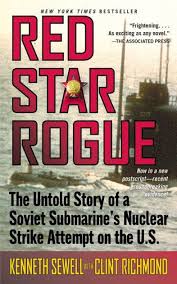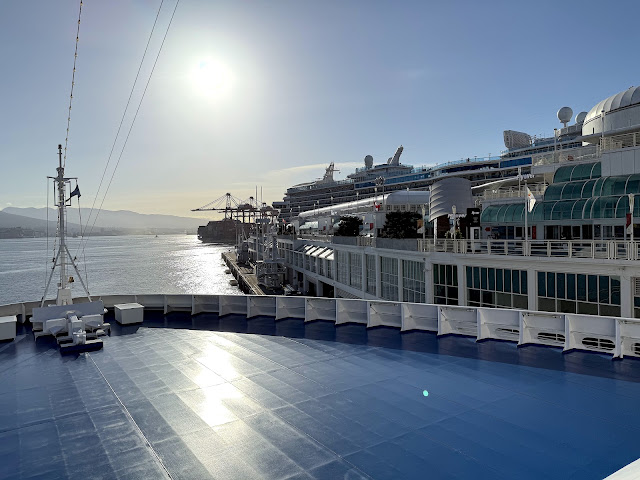 First of all, the Oceania Riviera cruise we're on is sailing through the Inside Passage. So far, we've seen a choppy ocean. All day. My filming with the new Pocket 3 has been a mini-disaster. I'll get better when I know how this new video camera works.
First of all, the Oceania Riviera cruise we're on is sailing through the Inside Passage. So far, we've seen a choppy ocean. All day. My filming with the new Pocket 3 has been a mini-disaster. I'll get better when I know how this new video camera works.
- For now, here is a half-hour mega tour of this ship from You Tube.
- Here is a short video purporting cruise the Inside Passage. Maybe there is not all that much to see after all.
- Maybe before we dock in Vancouver tomorrow I'll have something to show.
- His inspiration was fear of China.
- The order seeks to expedite permits in coastal waters of the U.S., while working with allied nations to share international resources.
- There are more than a billion tons of manganese nodules in U.S. waters, and the ocean can provide nickel, copper and rare earths currently being controlled by China.
- Could boost the U.S. GDP by $300 billion over the next decade, creating 100,000 jobs. Arthur D. Little says anticipates a $20 trillion future, as described later.
- My professional life has been free of much controversy. This subject, seabed mining, combined secrecy with intrigue and more, as you shall see.
- The law creating the Deep Seabed Hard Minerals Resource Act was enacted in 1980.
- Got $20? You can go to Amazon and buy this 276-page paperback for all the details.
- I was in those days an authority on the subject, for I participated in innumerable Law of the Sea sessions and assorted activities that followed.
- There is also something called the United Nations Convention on the Law of the Sea. This agreement was developed in parallel, and completed in 1982. However, the U.S. Senate for 43 years now has refused to ratify this treaty.
- Why? Because seabed mining firms have successfully lobbied to prevent this from happening.
- 164 countries have approved this agreement, with China ratifying it in 1996.
- Now that Trump has given the green light for development, more than ever, the Senate will never ratify the treaty, for his attitude is why share everything with others.
- Linked to the above is a totally different news story. This is where my life took a turn in the early 1980s into secrecy and intrigue.
- In March of 1968, the Soviet submarine K-129 sank 1560 nautical miles northwest of Hawaii, at a depth of 16,500 feet, or around 3 miles.
- I've previously written about the secret CIA operation called Project Azorian, which attempted to raise the submarine. My posting of 12August2014 describes how the USA duped the Soviet Union.
- The cover story was that the Hughes Glomar Explorer was being built in the early 70s to mine for seabed minerals.
- Cost was $350 million (probably worth closer to $2 billion in 2025 dollars).
- Began operations in 1974 to get the submarine.
- They raised the sub, but two-thirds of the ship broke off and fell back to the bottom.
- The CIA recovered two nuclear-tipped torpedoes, some cryptographic machines, and 6 Soviet bodies. However, missing were the key codebook and nuclear missiles.
- At least that was the secret report. Kenneth Sewell in Red Star Rogue (2005) claimed the CIA pretty much got everything they needed.
- Project Azorian became public in 2010.
- There is a movie entitled, Project Azorian: The CIA and the Raising of the K-129, which indicated that only the forward 38 feet of the submarine was recovered. Rotten Tomatoes audiences only gave it a 54 rating.
- The Glomar Explorer would have been useful if Lockheed had proceeded to mine for seabed minerals. However, the field was not ready for development, and the Glomar Explorer was dry docked at the Navy's Suisun Bay Reserve Fleet until 1978, when Lockheed and partners re-equipped the platform for deep sea drilling. Transferred ownership several times until 2015 when the Glomar Explorer was scrapped at Zhoushan, China.
- I knew much of the above by the nature of my job in the U.S. Senate, and have only since 2010 said much.
- Seabed minerals are primarily found in the abyssal plains of the deep ocean, at hydrothermal vents, and on the sides and summits of seamounts. Specifically, the Clarion-Clipperton Zone (CCZ) in the Pacific Ocean is a major area with high concentrations of polymetallic nodules, which are potato-shaped deposits containing valuable minerals like nickel,cobalt, manganese, and copper.
- Notice that Hawaii is adjacent to this promising site.
- Arthur D. Little indicated last year that seabed mining was a $20 trillion opportunity,
- Land-based mining is of course environmentally disastrous.
- Further ore grades are diminishing, environmental regulations are getting stricter and production costs are rising.
- Known seabed reserves show huge potential. Can't read the following? Click here.
- There are three types of deep-sea resources.
- Polymetallic manganese nodules. Value? $18.4 trillion.
- Seafloor massive sulfides. There are around 550 vent sites.
- Cobalt and manganese-rich crusts. Found in shallower waters. Rare earths.
- In 2021 Norway became the first country to approve mineral exploration and exploitation on its continental shelf.
- Japan is investing heavily in seabed mining technology and exploration, focusing on hydrothermal deposits in the Okinawa Trough.
- China has emerged as a key player, securing multiple exploration licenses in the CCZ and Indian Ocean.
- Which companies are involved?
- Industry has already screwed up our lands and atmosphere. Can seabed mining be conducted with no long-term impacts?
- The answer, of course, is no.
- But decisions will be made by countries threatened with development if minerals found in the seabed become necessary to maintain competition and progress.
- China controls 69% of global rare earth production and 90% of the refining capacity. This dominance is being used to bargain for tariffs, trade and loyalty.
- The ocean is wide open for harvest. Can this be accomplished economically with minimal environment damage? That is the question.
Probably my lowest pedometer reading on the entire trip, and this is now Day 28.
The Oceania Riviera arrived today in Vancouver. We had room service breakfast delivery, then left the ship at 9am or so.
Docked at Canada Place.Still snow on the mountains, and this is May 13.
All went well, and it was less than a 5-minute ride to our Marriott Pinnacle Downtown hotel. We fortunately were able to immediately go to our room. The view.
Tomorrow, Vancouver, Canada.-























Comments
Post a Comment